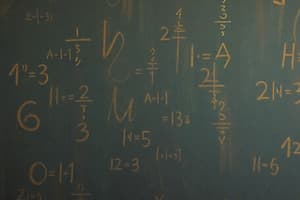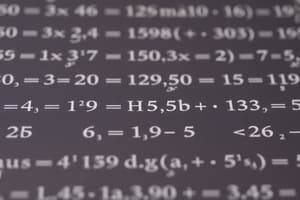Podcast
Questions and Answers
Simplify: $\frac{a^{5} \times a^{-2}}{a^{2}}$
Simplify: $\frac{a^{5} \times a^{-2}}{a^{2}}$
- $a^{9}$
- $a^{4}$
- $a$ (correct)
- $a^{-1}$
Evaluate: $(2 \times 10^{3}) \times (3 \times 10^{-5})$
Evaluate: $(2 \times 10^{3}) \times (3 \times 10^{-5})$
- $5 \times 10^{-2}$
- $6 \times 10^{-15}$
- $6 \times 10^{-2}$ (correct)
- $5 \times 10^{8}$
Which of the following numbers is irrational?
Which of the following numbers is irrational?
- $\sqrt{16}$
- $\frac{22}{7}$
- 3.14
- $\sqrt{12}$ (correct)
Express $\sqrt{72}$ in its simplest form.
Express $\sqrt{72}$ in its simplest form.
What is the value of $\sqrt[3]{216}$?
What is the value of $\sqrt[3]{216}$?
Convert the recurring decimal 0.$\overline{27}$ into a fraction.
Convert the recurring decimal 0.$\overline{27}$ into a fraction.
Simplify: $\frac{4^{5} \times 4^{-3}}{4^{-1}}$
Simplify: $\frac{4^{5} \times 4^{-3}}{4^{-1}}$
Express 0.000056 in standard form.
Express 0.000056 in standard form.
Which of these numbers is a rational number?
Which of these numbers is a rational number?
Simplify: $3\sqrt{20} - \sqrt{45} + \sqrt{5}$
Simplify: $3\sqrt{20} - \sqrt{45} + \sqrt{5}$
Determine the exact value of $\sqrt{784}$ using prime factorization.
Determine the exact value of $\sqrt{784}$ using prime factorization.
Simplify: $\frac{(3^2)^3 \times 3^{-2}}{3^{3}}$
Simplify: $\frac{(3^2)^3 \times 3^{-2}}{3^{3}}$
Express 456,000 in standard form.
Express 456,000 in standard form.
Which of the following values is a rational number?
Which of the following values is a rational number?
Simplify: $5\sqrt{12} - 2\sqrt{27}$
Simplify: $5\sqrt{12} - 2\sqrt{27}$
What is the simplified value of $\sqrt[3]{512}$?
What is the simplified value of $\sqrt[3]{512}$?
What fraction is equivalent to the recurring decimal 0.1$\overline{5}$?
What fraction is equivalent to the recurring decimal 0.1$\overline{5}$?
Simplify $\frac{5^{4} \times 5^{-2}}{5^{-1}}$
Simplify $\frac{5^{4} \times 5^{-2}}{5^{-1}}$
Flashcards
Product of Powers Rule
Product of Powers Rule
When multiplying powers with the same base, add the exponents: a^m * a^n = a^(m+n).
Quotient of Powers Rule
Quotient of Powers Rule
When dividing powers with the same base, subtract the exponents: a^m / a^n = a^(m-n).
Power of a Power Rule
Power of a Power Rule
To raise a power to a power, multiply the exponents: (a^m)^n = a^(m*n).
Zero Exponent Rule
Zero Exponent Rule
Signup and view all the flashcards
Standard Form (Scientific Notation)
Standard Form (Scientific Notation)
Signup and view all the flashcards
Rational Numbers
Rational Numbers
Signup and view all the flashcards
Irrational Numbers
Irrational Numbers
Signup and view all the flashcards
Simplifying Surds
Simplifying Surds
Signup and view all the flashcards
Exact Roots via Prime Factorization
Exact Roots via Prime Factorization
Signup and view all the flashcards
Recurring Decimal to Fraction
Recurring Decimal to Fraction
Signup and view all the flashcards
Study Notes
- Index Laws
Multiplication
- When multiplying terms with the same base, add the exponents: (a^m \times a^n = a^{m+n}).
- Example: (2^3 \times 2^2 = 2^{3+2} = 2^5 = 32).
Division
- When dividing terms with the same base, subtract the exponents: (a^m \div a^n = a^{m-n}).
- Example: (3^5 \div 3^2 = 3^{5-2} = 3^3 = 27).
Power of a Power
- When raising a power to another power, multiply the exponents: ((a^m)^n = a^{m \times n}).
- Example: ((5^2)^3 = 5^{2 \times 3} = 5^6 = 15625).
Zero Exponent
- Any non-zero number raised to the power of zero is 1: (a^0 = 1) (where (a \neq 0)).
- Example: (7^0 = 1).
Negative Exponent
- A negative exponent indicates a reciprocal: (a^{-n} = \frac{1}{a^n}).
- Example: (4^{-2} = \frac{1}{4^2} = \frac{1}{16}).
Fractional Exponent
-
A fractional exponent ( \frac{1}{n} ) indicates the ( n )th root: ( a^{\frac{1}{n}} = \sqrt[n]{a} ).
-
Example: ( 8^{\frac{1}{3}} = \sqrt[3]{8} = 2 ).
-
A fractional exponent ( \frac{m}{n} ) indicates both a power and a root: ( a^{\frac{m}{n}} = \sqrt[n]{a^m} = (\sqrt[n]{a})^m ).
-
Example: ( 9^{\frac{3}{2}} = \sqrt{9^3} = (\sqrt{9})^3 = 3^3 = 27 ).
-
Standard Form
Definition
- Standard form (also known as scientific notation) expresses numbers as (A \times 10^n), where (1 \leq |A| < 10) and (n) is an integer.
Expressing Large Numbers
- Move the decimal point to the left until there is only one non-zero digit to the left of the decimal point. The number of places moved is the value of (n).
- Example: (54300 = 5.43 \times 10^4).
Expressing Small Numbers
- Move the decimal point to the right until there is one non-zero digit to the left of the decimal point. The number of places moved is the value of (n), but it will be negative.
- Example: (0.0023 = 2.3 \times 10^{-3}).
Calculations
-
When multiplying numbers in standard form, multiply the (A) values and add the exponents.
-
Example: ((2 \times 10^3) \times (3 \times 10^4) = (2 \times 3) \times 10^{3+4} = 6 \times 10^7).
-
When dividing numbers in standard form, divide the (A) values and subtract the exponents.
-
Example: ((8 \times 10^5) \div (2 \times 10^2) = (8 \div 2) \times 10^{5-2} = 4 \times 10^3).
-
Rational and Irrational Numbers
Rational Numbers
- Definition: Numbers that can be expressed in the form ( \frac{p}{q} ), where ( p ) and ( q ) are integers and ( q \neq 0 ).
- Examples: ( \frac{1}{2} ), ( -3 ), ( 0.75 ) (which can be written as ( \frac{3}{4} )), ( \sqrt{4} = 2 ).
- Decimal representation: Rational numbers have decimal expansions that either terminate or repeat.
- Terminating decimals: ( 0.25 )
- Repeating decimals: ( 0.333... = 0.\overline{3} )
Irrational Numbers
- Definition: Numbers that cannot be expressed in the form ( \frac{p}{q} ), where ( p ) and ( q ) are integers.
- Examples: ( \sqrt{2} ), ( \pi ), ( e ).
- Decimal representation: Irrational numbers have non-terminating, non-repeating decimal expansions.
Key Differences
-
Rational numbers can be written as a simple fraction; irrational numbers cannot.
-
Rational numbers have decimal expansions that either terminate or repeat; irrational numbers do not.
-
Simplifying Surds and Solving Exact Roots Using Prime Factorisation
Simplifying Surds
- Surd Definition: A surd is an irrational number expressed as a root.
- Basic Simplification: Look for perfect square factors (or perfect cube, etc., depending on the root) within the surd.
- Example: ( \sqrt{8} = \sqrt{4 \times 2} = \sqrt{4} \times \sqrt{2} = 2\sqrt{2} ).
- General Form: ( \sqrt{a \times b} = \sqrt{a} \times \sqrt{b} )
Simplifying Surds with Larger Numbers
- Prime Factorisation: Break down the number under the square root into its prime factors.
- Example: Simplify ( \sqrt{180} ).
- Prime factorisation of 180: ( 180 = 2^2 \times 3^2 \times 5 ).
- ( \sqrt{180} = \sqrt{2^2 \times 3^2 \times 5} = \sqrt{2^2} \times \sqrt{3^2} \times \sqrt{5} = 2 \times 3 \times \sqrt{5} = 6\sqrt{5} ).
Solving Exact Roots Using Prime Factorisation
- Prime Factorisation Method: Use prime factorisation to find exact roots, particularly for cube roots, fourth roots, etc.
- Example: Find ( \sqrt[3]{216} ).
- Prime factorisation of 216: ( 216 = 2^3 \times 3^3 ).
- ( \sqrt[3]{216} = \sqrt[3]{2^3 \times 3^3} = \sqrt[3]{2^3} \times \sqrt[3]{3^3} = 2 \times 3 = 6 ).
Example with Higher Root
-
Find ( \sqrt[4]{625} ).
-
Prime factorisation of 625: ( 625 = 5^4 ).
-
( \sqrt[4]{625} = \sqrt[4]{5^4} = 5 ).
-
Changing Recurring Decimals to Fractions
Recurring Decimals
- Definition: A recurring decimal (or repeating decimal) is a decimal number that has a repeating sequence of digits after the decimal point.
Method
- Let ( x ) be the recurring decimal.
- Multiply ( x ) by a power of 10 (e.g., 10, 100, 1000) such that the repeating part lines up.
- ( 10x, 100x, 1000x )
- Subtract ( x ) (or a multiple of ( x )) from this new equation to eliminate the repeating part.
- Solve for ( x ) to express as a fraction.
Simple Recurring Decimal Example
- Convert ( 0.\overline{3} ) to a fraction.
- Let ( x = 0.333... )
- Multiply by 10: ( 10x = 3.333... )
- Subtract ( x ) from ( 10x ): ( 10x - x = 3.333... - 0.333... )
- ( 9x = 3 )
- ( x = \frac{3}{9} = \frac{1}{3} )
More Complex Recurring Decimal Example
- Convert ( 0.\overline{27} ) to a fraction.
- Let ( x = 0.272727... )
- Multiply by 100: ( 100x = 27.272727... )
- Subtract ( x ) from ( 100x ): ( 100x - x = 27.272727... - 0.272727... )
- ( 99x = 27 )
- ( x = \frac{27}{99} = \frac{3}{11} )
Example with Non-Repeating Part
- Convert ( 0.1\overline{6} ) to a fraction.
- Let ( x = 0.1666... )
- Multiply by 10: ( 10x = 1.666... )
- Multiply by 100: ( 100x = 16.666... )
- Subtract ( 10x ) from ( 100x ): ( 100x - 10x = 16.666... - 1.666... )
- ( 90x = 15 )
- ( x = \frac{15}{90} = \frac{1}{6} )
Studying That Suits You
Use AI to generate personalized quizzes and flashcards to suit your learning preferences.



